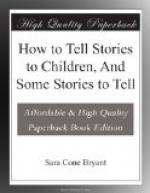I have since wished that every city primary teacher could have visited with me the first-grade room in Providence where the pupils were German, Russian, or Polish Jews, and where some of them had heard no English previous to that year,—it being then May. The joy that shone on their faces was nothing less than radiance when the low-voiced teacher said, “Would you like to tell these ladies some of your stories?”
They told us their stories, and there was truly not one told poorly or inexpressively; all the children had learned something of the joy of creative effort. But one little fellow stands out in my memory beyond all the rest, yet as a type of all the rest.
Rudolph was very small, and square, and merry of eye; life was one eagerness and expectancy to him. He knew no English beyond that of one school year. But he stood staunchly in his place and told me the story of the Little Half Chick with an abandon and bodily emphasis which left no doubt of his sympathetic understanding of every word. The depth of moral reproach in his tone was quite beyond description when he said, “Little Half Chick, little Half Chick, when I was in trubbul you wouldn’t help me!” He heartily relished that repetition, and became more dramatic each time.
Through it all, in the tones of the tender little voice, the sidewise pose of the neat dark head, and the occasional use of a chubby pointing finger, one could trace a vague reflection of the teacher’s manner. It was not strong enough to dominate at all over the child’s personality, but it was strong enough to suggest possibilities.
In different rooms, I was told The Half Chick, The Little Red Hen, The Three Bears, The Red-Headed Woodpecker, The Fox and the Grapes, and many other simple stories, and in every instance there was a noticeable degree of spontaneity and command of expression.
When the reading classes were held, the influence of this work was very visible. It had crept into the teachers’ method, as well as the children’s attitude. The story interest was still paramount. In the discussion, in the teachers’ remarks, and in the actual reading, there was a joyousness and an interest in the subject-matter which totally precluded that preoccupation with sounds and syllables so deadly to any real progress in reading. There was less of the mechanical in the reading than in any I had heard in my visits to schools; but it was exceptionally accurate.
The second form of giving back which has proved a keen pleasure and a stimulus to growth is a kind of “seat-work.” The children are allowed to make original illustrations of the stories by cutting silhouette pictures.
It will be readily seen that no child can do this without visualising each image very perfectly. In the simplest and most unconscious way possible, the small artists are developing the power of conceiving and holding the concrete image of an idea given, the power which is at the bottom of all arts of expression.




